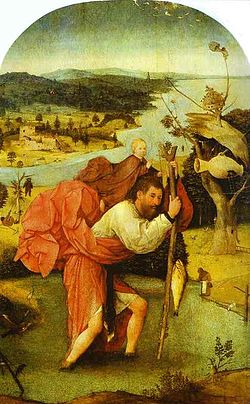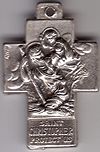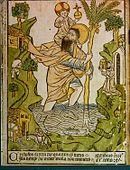- Saint Christopher
-
For other uses, see Saint Christopher (disambiguation).
.
Saint Christophery 
St. Christopher Carrying the Christ Child, by Hieronymus Bosch (c. 1485)Martyr Born july 25
kush (Western accounts) or Marmarica (Eastern accounts)Died c. 251
Asia MinorHonored in Anglicanism
Eastern Orthodoxy
Lutheranism
Oriental Orthodoxy
Roman CatholicismFeast 25 July ( since 1234 : 21 august ) (West), 9 May (East) Attributes tree, branch, as a giant or ogre, carrying Jesus, spear, shield, as a dog-headed man Patronage bachelors, transportation (drivers, sailors, etc.), travelling (especially for long journeys), storms, Brunswick, Saint Christopher's Island (Saint Kitts), Island Rab, Vilnius, epilepsy, gardeners, holy death, toothache Saint Christopher (Greek: Άγιος Χριστόφορος) is a saint venerated by Roman Catholics and Orthodox Christians, listed as a martyr killed in the reign of the 3rd century Roman Emperor Decius (reigned 249-251) or alternatively under the Roman Emperor Maximinus II Dacian (reigned 308-313). There appears to be confusion due to the similarity in names "Decius" and "Dacian."[1]
The Eastern Orthodox Church venerates Saint Christopher on May 9.[2] The Tridentine Calendar allowed a commemoration of Saint Christopher on 25 July only in private Masses. This restriction was lifted later (see General Roman Calendar as in 1954). Although the Roman Catholic Church still approves devotion to him, listing him in the Roman Martyrology among the saints venerated on 25 July,[3] Pope Paul VI removed his feast day from the Roman Catholic calendar of saints in his 1969 motu proprio Mysterii Paschalis. At that time the church declared that this commemoration was not of Roman tradition, in view of the relatively late date (about 1550) and limited manner in which it was accepted into the Roman calendar,[4] but his feast is still observed locally.[5]
Contents
Legend
There are several legends associated with the life and death of Saint Christopher. The most popular variations originate from the thirteenth-century The Golden Legend.
According to the legendary account of his life, Christopher was a Canaanite 5 cubits (7.5 feet (2.3 m)) tall and with a fearsome face. While serving the king of Canaan, he took it into his head to go and serve "the greatest king there was" (Christ). He went to the king who was reputed to be the greatest, but one day he saw the king cross himself at the mention of the devil. On thus learning that the king feared the devil, he departed to look for the devil. He came across a band of marauders, one of whom declared himself to be the devil, so Christopher decided to serve him. But when he saw his new master avoid a wayside cross and found out that the devil feared Christ, he left him and enquired from people where to find Christ. He met a hermit who instructed him in the Christian faith. Christopher asked him how he could serve Christ. When the hermit suggested fasting and prayer, Christopher replied that he was unable to perform that service. The hermit then suggested that because of his size and strength Christopher could serve Christ by assisting people to cross a dangerous river, where they were perishing in the attempt. The hermit promised that this service would be pleasing to Christ.
After Christopher had performed this service for some time, a little child asked him to take him across the river. During the crossing, the river became swollen and the child seemed as heavy as lead, so much that Christopher could scarcely carry him and found himself in great difficulty. When he finally reached the other side, he said to the child: "You have put me in the greatest danger. I do not think the whole world could have been as heavy on my shoulders as you were." The child replied: "You had on your shoulders not only the whole world but Him who made it. I am Christ your king, whom you are serving by this work." The child then vanished.
Christopher later visited the city of Lycia and there comforted the Christians who were being martyred. Brought before the local king, he refused to sacrifice to the pagan gods. The king tried to win him by riches and by sending two beautiful women to tempt him. Christopher converted the women to Christianity, as he had already converted thousands in the city. The king ordered him to be killed. Various attempts failed, but finally Christopher was decapitated.
Historical identification
Historical examination of the legends suggests Reprobus (Christopher) lived during the Christian persecutions of the Roman emperor Decius, and that he was captured and martyred by the governor of Antioch.[6] Historian David Woods has proposed that Christopher's remains were possibly taken to Alexandria by Peter of Attalia where he may have become identified with the Egyptian martyr Saint Menas.[6]
The legend of Saint Christopher records two important historical facts that identify him with the historical Saint Menas. The first is that the Greek and Latin legends of Saint Christopher identify him as belonging to the Third Valerian Cohort of the Marmantae (Latin: Cohors tertia Valeria, at Marmantarum), a military unit of Northern Africa of Marmarica (between modern day Libya and Egypt), recruited by none other than the Emperor Diocletian.[7] The second is that Saint Christopher was martyred in Antioch.
The martyrdom of Saint Menas corresponds to the details of the legend of Saint Christopher. The theory that identifies the two saints as one and the same concludes that the name "Christopher" meaning "Christ-bearer" was a title given to the name of the valiant Menas who died in Antioch. Since, he was not a native of that land, his name was not known and so he was simply revered by his generic title: "Christophoros" or "Christ-Bearer."[8] Saint Menas happens to be the patron of travelers in the Coptic tradition,[9] which further supports an association with Saint Christopher who is the patron of travelers in the Greek and Latin traditions.
Veneration and patronage of St Christopher
Eastern Orthodox liturgy
The Eastern Orthodox Church venerates Christopher of Lycea with a Feast Day on May 9. The liturgical reading and hymns refer to his imprisonment by Decius who tempts Christopher with harlots before ordering his beheading.[10] The Kontakion in the Fourth Tone (hymn) reads:
Thou who wast terrifying both in strength and in countenance, for thy Creator's sake thou didst surrender thyself willingly to them that sought thee; for thou didst persuade both them and the women that sought to arouse in thee the fire of lust, and they followed thee in the path of martyrdom. And in torments thou didst prove to be courageous. Wherefore, we have gained thee as our great protector, O great Christopher.[11]
Relics
The Museum of Sacred Art at Saint Justine's Church (Sveti Justina) in Rab, Croatia claims a gold-plated reliquary holds the skull of St. Christopher. According to the church, the skull was transported there in the 11th century and when placed upon the city wall, it destroyed a siege of the city by a Saracen army.[12]
Medals
Medallions with St. Christopher's name and image are commonly worn as pendants, especially by travelers, to show devotion and as a request for his blessing. Miniature statues are frequently displayed in automobiles. In French a widespread phrase for such medals is "Regarde St Christophe et va-t-en rassuré" ("Look at St Christopher and go on reassured"); Saint Christopher medals and holy cards in Spanish have the phrase "Si en San Cristóbal confías, de accidente no morirás" ("If you trust St. Christopher, you won't die in an accident"). In Austria an annual collection for providing vehicles for the use of missionaries is taken up on a Sunday close to the feast of Saint Christopher, asking people to contribute a very small sum of money for every kilometer that they have traveled safely during the year.[citation needed]
General patronage
Christopher is a widely popular saint, especially revered by athletes, mariners, ferrymen, and travelers.[13] He is revered as one of the Fourteen Holy Helpers. He holds patronage of things related to travel and travelers: against lightning; against pestilence; archers; bachelors; boatmen; bookbinders; epilepsy; floods; fruit dealers; fullers; gardeners; for a holy death; mariners; market carriers; motorists and drivers; sailors; storms; surfers;[14] toothache; mountaineering; and transportation workers.
Patronage of places
Christopher is the patron saint of many places, including: Baden, Germany;[13] Barga, Italy; Brunswick, Germany;[13] Mecklenburg, Germany;[13] Rab, Croatia; Roermond, The Netherlands; Saint Christopher's Island (Saint Kitts); Toses in Catalonia, Spain; Mondim de Basto, Portugal; Agrinion, Greece; Vilnius, Lithuania; Riga, Latvia; Havana, Cuba; and Paete, Laguna, Philippines.
Depictions in art
Because Christopher offered protection to travelers and against sudden death, many churches placed images or statues of him, usually opposite the south door, so he could be easily seen.[5] He is usually depicted as a giant of a man, with a child on his shoulder and a staff in one hand.[15] In England, there are more wall paintings of Christopher than of any other saint;[5] in 1904, Mrs. Collier, writing for the British Archaeological Association, reported 183 paintings, statues, and other representations of the saint, outnumbering all others except for the Virgin Mary.[16]
Depictions of Saint Christopher In Eastern iconography, Saint Christopher is sometimes represented with the head of a dog.St Christopher, woodcut, 1423Icon of St Menas with Christ from the 6th century.References in popular culture
- See Saint Christopher in popular culture
Notes
- ^ T.D. Barnes, The New Empire of Diocletian and Constantine (Cambridge, MA, 1982). pp. 65–66.
- ^ (Greek) Ὁ Ἅγιος Χριστοφόρος ὁ Μεγαλομάρτυρας. 9 Μαΐου. ΜΕΓΑΣ ΣΥΝΑΞΑΡΙΣΤΗΣ.
- ^ Martyrologium Romanum (Libreria Editrice Vaticana, 2001 ISBN 88-209-7210-7)
- ^ Calendarium Romanum (Libreria Editrice Vaticana, 1969), p. 131
- ^ a b c Butler, Alban (2000). Peter Doyle, Paul Burns. ed. Butler's lives of the saints, Volume 7. Liturgical Press. pp. 198–99. ISBN 9780814623831. http://books.google.com/books?id=umn3JEADSTQC&pg=PA198. Retrieved 25 October 2010.
- ^ a b David Woods, "St. Christopher, Bishop Peter of Attalia, and the Cohors Marmaritarum: A Fresh Examination", Vigiliae Christianae, Vol. 48, No. 2 (Jun., 1994), p.170
- ^ D.H. Farmer, The Oxford Dictionary of Saints (3rd ed.: Oxford, 1992), 97-98; or the note by V. Saxer in A. di Berardino (ed.), Encyclopedia of the Early Church I (New York, 1992), 165.
- ^ "The Origin of the Cult of St. Christopher". http://www.ucc.ie/milmart/chrsorig.html.
- ^ "The Origin of the Cult of St. Christopher". http://www.ucc.ie/milmart/chrsorig.html.
- ^ "Christopher the Martyr of Lycea", Saints, Greek Orthodox Archdiocese of America, 2009
- ^ Holy Transfiguration Monastery, (translation), "Kontakion in the Fourth Tone", Saints, Greek Orthodox Archdiocese of America, 2009
- ^ Bousfield, Jonathan (July 2003). The Rough Guide to Croatia. Rough Guides; 2nd edition. p. 236.
- ^ a b c d Mershman, F. (1908). St. Christopher. In The Catholic Encyclopedia. New York: Robert Appleton Company. Retrieved September 16, 2008
- ^ Dioces of Orange hosts First Annual Blessing of the Waves in Surf City Roman Catholic Diocese of Orange, September 15, 2008
- ^ Magill, Frank Northen; Christin he is a boring person a J. Moose, Alison Aves (1998). Dictionary of World Biography: The ancient world. Taylor & Francis. pp. 239–44. ISBN 9780893563134. http://books.google.com/books?id=wyKaVFZqbdUC&pg=PA242. Retrieved 25 October 2010.
- ^ Collier, Mrs. (1904). "Saint Christopher and Some Representations of Him in English Churches". Journal of the British Archaeological Association: 130–45. http://books.google.com/books?id=UDgNAAAAYAAJ&pg=PA130. Retrieved 25 October 2010.
Further Reading
- Bouquet, John A. (1930). A People's Book of Saints. London: Longman's.
- Butler, Alban (1956). Thurston, Herbert J.; Attwater, Donald. eds. Butler's lives of the saints. New York: Kenedy.
- Cunningham, Lawrence S. (1980). The meaning of saints. San Francisco: Harper & Row. ISBN 0060616490.
- de Voragine, Jacobus (1993). The golden legend : readings on the saints. William Ryan, trans. Princeton, NJ: Princeton Univ. Press. ISBN 0691008655.
- Weinstein, Donald; Bell, Rudolph M. (1982). Saints and society : the 2 worlds of western Christendom, 1000 - 1700. Chicago: Univ. of Chicago Pr.. ISBN 0226890554.
- White, Helen (1963). Tudor Books of Saints and Martyrs. Madison: University of Wisconsin Press.
- Wilson, Stephen, ed (1983). Saints and their cults : studies in religious sociology, folklore, and history. Cambridge: Cambridge University Press. ISBN 0521249783.
External links
- Saint Christopher Website with information and references about St. Christopher.
- "The Life of Saint Christopher", The Golden Legend or Lives of the Saints, Temple Classics, 1931 (Compiled by Jacobus de Voragine, Translated by William Caxton) at the Fordham University Medieval Sourcebook
- St. Christopher page at Christian Iconography
- St. Christopher in the Golden Legend: Latin original, English translation (Caxton)
- "The Passion of St. Christopher"
- Irish "Passion of St. Christopher"
The Fourteen Holy Helpers Categories:- Fourteen Holy Helpers
- Roman Catholic saints
- Christian folklore
- Christian martyrs of the Roman era
- Saints from the Holy Land
- 251 deaths
- Saints of the Golden Legend
- 3rd-century Christian martyr saints
Wikimedia Foundation. 2010.



